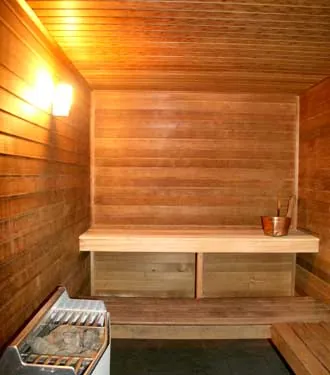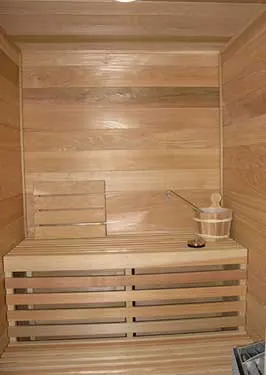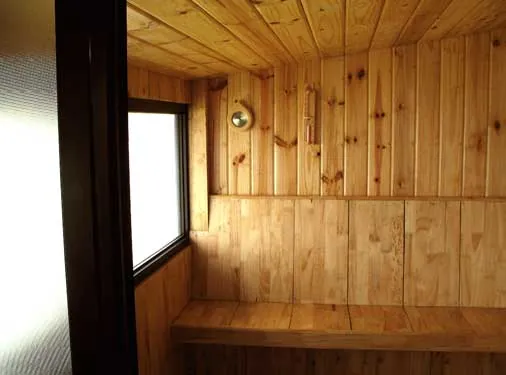 by Jennifer Jones
by Jennifer Jones

Humans have been enjoying the benefits of saunas for thousands of years. However, modern day saunas have evolved quite a bit from the primitive ones. Nowadays, saunas are usually designed as a small room where people undergo a wet or dry heat session. The participants often disrobe or enter the room with just a towel. The heat in the sauna can range from 100°F and 212°F, depending on the type of sauna. Some people enjoy saunas as a social experience with friends, while others prefer to sweat by themselves. Although they were originally used for bathing, modern saunas are used to promote sweating, cleansing and relaxing.
Wandering Finnish nomads originated what is thought to be the first saunas hundreds of years ago. They would dig a pit (like a small cave) on a sloping ground and use it as a fireplace to heat stones to a high temperature. Once the stones were hot enough, they would throw water on them to produce steam. Often used as a social gathering space, the steam would make the space so hot that they would remove their clothes. The Finnish would take a sauna bath the night before a feast or special holiday. Since these early saunas usually had available water and were the cleanest structures, they were also utilized for bathing, healing the sick, preparing the dead for burial and giving birth. It was believed that the sauna refreshed the spirit and cleansed the mind.
As the Finns travelled to other parts of the world, they introduced other cultures to the benefits of the sauna. Metal woodstoves with a chimney were created during the Industrial Revolution in the early 19th century. Electric heaters were developed in the 1940’s as a more efficient way to heat a sauna. In just the last few decades, infrared saunas have been designed to produce the healthy benefits of natural sunlight to more efficiently detoxify the body.

View This House Plan
View Other House Plans with Saunas
If you are considering purchasing a sauna for your home, the location of your new sauna is very important. It cannot be installed on carpet or any other surface that can absorb moisture. Linoleum, tile and concrete will provide a safe and sturdy base for your sauna. Some homeowners purchase a sauna kit that they can personally customize, and take it to a manufacturer that can supply the materials, base plan and an enclosure for the kit. The kits usually do not include insulation, wiring and lumber, so you or your contractor will have to provide these materials. There are a wide variety of saunas available in today’s market. Wet, dry, smoke, steam and infrared saunas are some of the options. Depending upon the type of sauna, they are heated in a number of ways from wood and electricity to gas and solar power. There are two main options that differ in temperature and heating method: traditional and far infrared saunas.

Traditional Heat Saunas
These saunas, otherwise know as conventional saunas, work by warming the air inside the structure. Many people love the steamy, hot atmosphere that is created by traditional saunas. They feel that the humidity and steam that is created by pouring water over the hot rocks is stimulating and refreshing. Since traditional saunas operate with high humidity levels, they must be constructed from durable softwood, such as cedar. Conventional saunas are powered by heating stoves that range from wood burning to electric. Heat storage and continuous heat are two methods that are utilized by traditional saunas.
The classic form of a heat storage sauna is known as a smoke sauna. It consists of a room without a chimney arranged around a pile of rocks and a fire as the main source of heat. After the fire has warmed the rocks, it is extinguished. Unfortunately, the smoke deposits a layer of soot on every surface in the room and it must be cleaned after each use. To avoid this issue, a smoke-sauna stove that includes a chimney and insulated stone compartment eliminates the irritation and odor caused from smoke saunas. The stones get so hot that they glow red and even white-hot. Since they are free of dirt and dust, the heat that is produced is soft and clean. Heat storage stoves take quite a bit of time to heat a sauna, since the main heat is not released until the stove shutter is opened to allow the warmth into the bathing room. However once the stove is opened, the sauna can get as hot as 212°F and is very high in humidity. Heat-storing stoves can be purchased with electric-powered heating elements, thus eliminating the maintenance of a fire.
A more recent invention for heating a sauna is the continuous heat fire stove. It consists of a section of stones placed above the firebox with a smokestack. Bathing is done while the fire is lit; not after the fire has been extinguished like heat storage stoves. Continuously heating stoves can heat up a sauna in about an hour, but requires the labor of maintaining the fire. For people who are concerned with the hazard of a fire, an electrical stove may provide more comfort. These stoves are warmed by electrical heating elements and usually include a thermostat and a timer. Continuous electrical heating stoves are popularly used in urban saunas.
Infrared Saunas
A newer technology that uses infrared rays to heat the body has become increasing popular the last few years. Infrared saunas consist of pre-fabricated panels that are attached to the interior walls of the sauna room. The heating elements in the panels are usually carbon or ceramic. Since there is no humidity produced in infrared heating, the type of wood used to build the walls increases in options. Cedar is still the popular choice thanks to its welcoming aroma.

Infrared saunas operate at much lower levels than traditional saunas, around 100°F to 150°F. This lower temperature provides a safer environment for people with certain health issues that still want to enjoy a sauna. It is a milder heat for people who cannot handle the intense heat of a conventional sauna. The infrared rays directly heat the body and indirectly warm the air. These energy rays deeply penetrate the skin, some up to three inches, thus heating internal organs and muscular tissues as well. The tissue cells react in a process known as “resonant absorption,” that forces toxins to be excreted through sweating. This gentle penetration can generate twice as much sweat than a traditional sauna, increasing the beneficial healing effects. Unlike traditional saunas, the radiant heat does not dry out your mucous membranes.
All in all, the type of home sauna that you choose depends upon your personal preference. Some people get satisfaction from pouring water over the hot rocks to produce a steamy atmosphere. Others find the lower temperatures of radiant rays more soothing. Whether you prefer a traditional sauna, infrared sauna or sauna pit on the side of a hill, the relaxation and health benefits are definitely beneficial to your body.
Here are some related articles:
Save this article to:
back to top